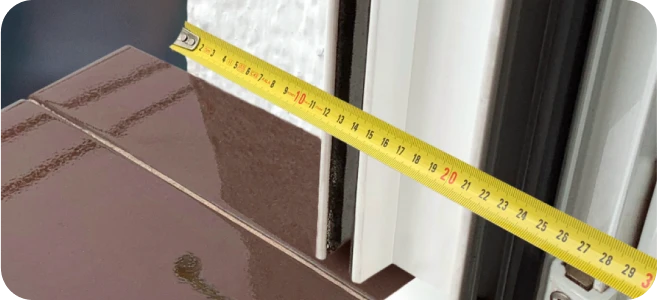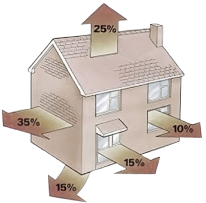Find the perfect solution to isolate your home
Blown thermal insulation requires an air chamber, but thanks to our Smart solutions you can also achieve an efficient home and save on your energy bill. Find out which one is the best for you:
Save on your bills with Smart Thermal Insulation. Minimise the amount of heat and cold you waste and improve the comfort of your home.


Consume less energy and reduce your gas or electricity bill by up to 30%.
One-day installation without building works. Maintenance-free, with no associated costs.
More comfort at home, both in winter and summer. Reduces outside noise.
You can finance the installation of insulation according to your needs.
Each property is unique and requires a customised study. Here are some examples to give you an idea:
Your quote with no obligation
A specialised technician will visit your home to give you an estimate tailored to your home.
(*) The reduced VAT rate of 10% applies to natural persons in private homes (not for professional or business purposes) and residents' associations
Please select an option to continue.
Please select an option to continue.
Roof insulation can vary greatly from house to house. For a better assessment, request a no-obligation quote and a specialised Iberdrola technician will visit your home and make a customised assessment of your home.
Please select an option to continue.
Roof insulation can vary greatly from house to house. For a better assessment, request a no-obligation quote and a specialised Iberdrola technician will visit your home and make a customised assessment of your home.
Please select an option to continue.
Roof insulation can vary greatly from house to house. For a better assessment, request a no-obligation quote and a specialised Iberdrola technician will visit your home and make a customised assessment of your home.
Please select an option to continue.
If it was built between 1960 and 2006, it is likely to have an air chamber. If you are not sure, we will use an average thickness (7 cm) to give you an approximate price. A visit from our collaborating technician will be necessary in order to provide you with a customised quote.
Air chambers with a thickness of less than 3 cm are not suitable for thermal insulation.
Please select an option to continue.

Until you receive a visit from one of our technicians to measure and advise you on blown thermal insulation, you can get a rough idea by measuring the thickness of your façade on a window. Try to cover the whole "solid" part of the enclosure. The side of the window may be a good place using a flexometer or tape measure.
Blown thermal insulation requires an air chamber, but thanks to our Smart solutions you can also achieve an efficient home and save on your energy bill. Find out which one is the best for you:

Control your home from your mobile: from heating to lights. All from the same place, easy and smart.
Find out more
Turn on and off and control temperature in your home, wherever you are. It’s much easier now.
Find out more
We have received your request and we will call you right away.
Thanks
€/month incl. VAT in 12 interest-free payments
Estimated price for
m linear meters of exterior façade insultarion, height of 2.5m and 20% of wall cavities. Volume of wall cavity to be filled approximately
m3.Estimated reduction of heating and cooling consumption of 15% for homes constructed before 1980, and of 10% for homes constructed between 1980 y 2006
m3.Estimated reduction of heating and cooling consumption of 20% for homes constructed before 1980, and of 15% for homes constructed between 1980 y 2006


Join the change, at Iberdrola we help you to be more efficient with your energy and maximise your savings.
Here are some of the most frequently asked questions

| Glass mineral wool |
Polyurethane | Rock wool | Cellulose | EPS |
|---|---|---|---|---|
| Thermal properties | ||||
Excellent (Conductivity 0,034w/m2k)
|
Excellent (Conductivity 0,034w/m2k)
|
Good (Conductivity 0,038w/m2k)
|
Good (Conductivity 0,040w/m2k)
|
Excellent (Conductivity 0,035w/m2k)
|
| Fire resistance | ||||
Flame-resistant (Euroclass A1)
|
Inflammable (Euroclass E)
|
Flame-resistant (Euroclass A1)
|
Fire resistant (Euroclass B2)
|
Fire resistant (Euroclass B2)
|
| Water absorption | ||||
Waster resistant
|
Waster resistant
|
Waster resistant
|
Does not resist water
|
Waster resistant
|
| Durability | ||||
Long-lasting (Settlement S1)
|
Losses quality
|
Long-lasting (Settlement S1)
|
Losses quality(Settlement S3)
|
Long-lasting (Settlement S1)
|
| Drilling | ||||
Nozzle (From 16)
|
Nozzle (From 16)
|
Nozzle (Usually 38)
|
Nozzle (Usually 38)
|
Nozzle (From 16)
|
| Sound insulation | ||||
Good isolation
|
Does not isolate
|
Good isolation
|
Good isolation
|
Does not isolate
|
| Thermal properties | |
|---|---|
| Glass mineral wool | Excellent (Conductivity 0,034w/m2k)
|
| Polyurethane | Excellent (Conductivity 0,034w/m2k)
|
| Rock wool | Good (Conductivity 0,038w/m2k)
|
| Cellulose | Good (Conductivity 0,040w/m2k)
|
| EPS | Excellent (Conductivity 0,035w/m2k)
|
| Fire resistance | |
|---|---|
| Glass mineral wool | Flame-resistant (Euroclass A1)
|
| Polyurethane | Inflammable (Euroclass E)
|
| Rock wool | Flame-resistant (Euroclass A1)
|
| Cellulose | Fire resistant (Euroclass B2)
|
| EPS | Fire resistant (Euroclass B2)
|
| Water absorption | |
|---|---|
| Glass mineral wool | Waster resistant
|
| Polyurethane | Waster resistant
|
| Rock wool | Waster resistant
|
| Cellulose | Waster resistant
|
| EPS | Waster resistant
|
| Durability | |
|---|---|
| Glass mineral wool | Long-lasting (Settlement S1)
|
| Polyurethane | Losses quality
|
| Rock wool | Long-lasting (Settlement S1)
|
| Cellulose | Losses quality(Settlement S3)
|
| EPS | Long-lasting (Settlement S1)
|
| Drilling | |
|---|---|
| Glass mineral wool | Nozzle (From 16)
|
| Polyurethane | Nozzle (From 16)
|
| Rock wool | Nozzle (Usually 38)
|
| Cellulose | Nozzle (Usually 38)
|
| EPS | Nozzle (From 16)
|
| Sound insulation | |
|---|---|
| Glass mineral wool | Good isolation
|
| Polyurethane | Does not isolate
|
| Rock wool | Good isolation
|
| Cellulose | Good isolation
|
| EPS | Does not isolate
|
We call you

May we help you?